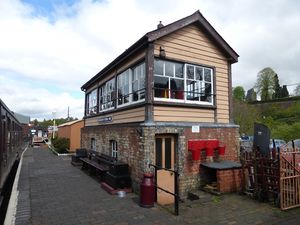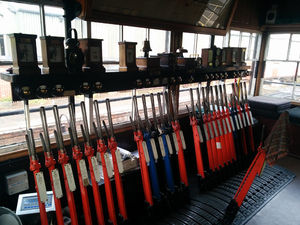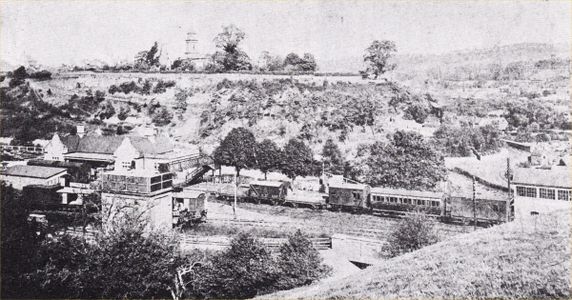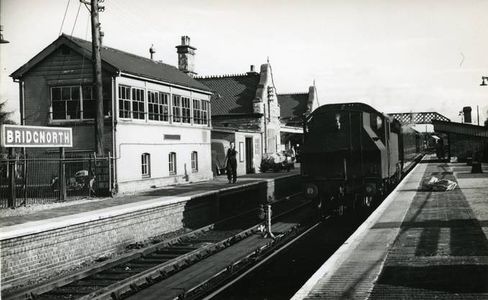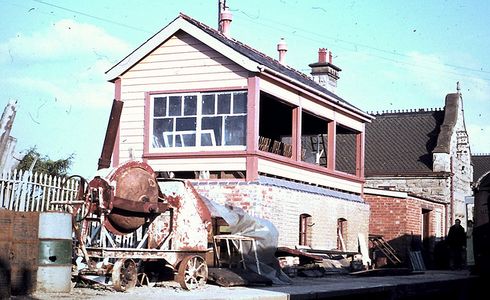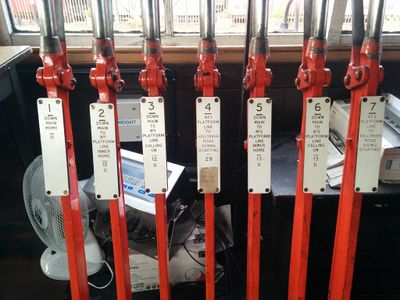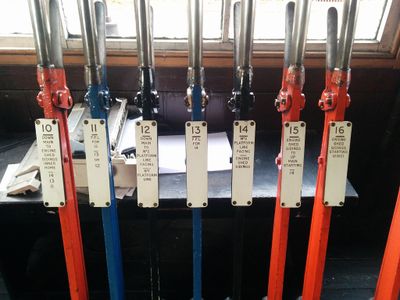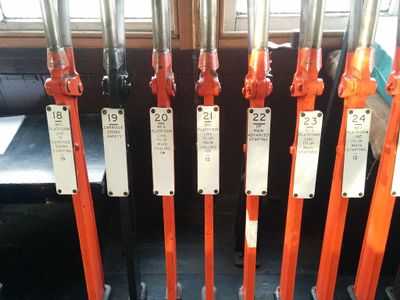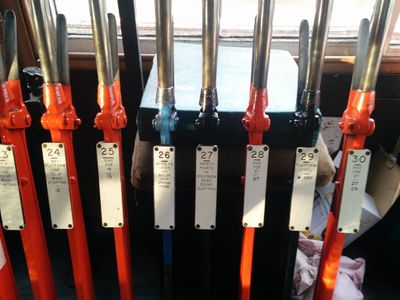Bridgnorth signal box
A signal box at Bridgnorth that works to Hampton Loade (short section) or Highley (long section) using ETT regulations.
Contents
History
Bridgnorth has had a number of signal boxes during its existence. Initially construction of two boxes was authorised on 13 August 1891 at an estimated cost of £3,103 and these were brought into use in October 1892.
Bridgnorth North signal box was situated north of the station on the Down side, where the two lines converged into the single line. The foundations can still be made out on the embankment side.
Bridgnorth South signal box was at the south end of the station on the Up side, opposite Pan Pudding Hill where it could control access to the goods yard[1].
In 1923 both boxes were replaced by a large single central signal box with 54 levers, and a track circuit was installed to lock the Up starting signal.[2][3] It was far larger than Bridgnorth Station layout really required with many spaces in the lever frame. This was future-proofing for alterations required for the planned line from Wolverhampton which reached Kingswinford in 1925 but was never completed.
The pre-preservation signal box in September 1962 (Sellick Collection)
Passenger services through Bridgnorth ended on 9 September 1963. The box remained open to handle through goods traffic; however this only lasted until 30 November after which the box was closed by BR on 2 December 1963.
Preservation
In 1964 dismantling of the track began southwards from Buildwas. After a pause, work resumed at Bridgnorth on 25 July 1964. The Severn Valley Railway Society, which had been formed some three weeks earlier, managed to halt the work but not before the signalling equipment had been removed from the box and the upper structure had been demolished.[4]
The SVR's S&T Department was formed at the beginning of July 1967. A priority at Bridgnorth was seen as the installation of a replacement frame in the old signal box building, the running of signal wires and point rodding and the erection of signals.[5]
By early 1968 work was underway to install the ex-Windmill End junction lever frame. This had a capacity for 30 levers, although only 18 were to be fitted initially with another nine at a later date when funds permitted, leaving three spares. Parts of the interlocking and signalling instruments were also taken from Arley signal box, which would later require that box in turn to be re-equipped when the SVR extended southwards.[6] The signal box lever frame at Ledbury North End had also been purchased by the S&T department who planned to adapt it for use in the Hampton Loade signal box, with certain parts also being used in the Bridgnorth frame.[7][8] By that summer the majority of the levers had been positioned and work was proceeding with the point connections.[9]
During 1968 a redundant box had been spotted at Pensnett on the old GWR Wombourn branch by members of the S&T department. This was subsequently purchased to replace the missing upper woodwork and roof. The first working party at Pensnett on 7 September concentrated on removing the slates from the roof. On the weekend of 5-6 October, the rest of the slates and roof timbers were removed. The levers and locking bars were also removed for use in the rebuilding of Hampton Loade box. By 3 November all the roof sections had been taken down. The weekend of 30 November saw all the internal tongued and grooved boarding and the gables off the roof brought back to Bridgnorth.[10]
The Pensnett box was smaller than the old central signal box it was to replace, requiring the north end of the masonry base at Bridgnorth to be reduced by 9 feet in length.[11] This was carried out over one weekend, with Society members later cleaning up over 1,300 recovered bricks for re-use. The new end wall was then rebuilt.[10] As a result of the rebuilding, the box now has only two windows at the ground floor level where the original had three. Evidence of the truncation may be found by inspection of the brickwork towards the northern end on the front wall.
In mid-January 1969 the five large main wall sections weighing over two tons were transported from Pensnett to Bridgnorth, the largest front section requiring 22 men to lift it onto the articulated lorry. On Sunday 25 January the five large units were lifted into their permanent position on the brickwork with the aid of a mobile crane. Over the next three months the roof was installed and covered with the slates recovered from Pensnett. The ledge left around the perimeter of the box due to the Pensnett box being a few inches undersize was covered with splayed blue plinth bricks to cover any signs of a "transplant". One of the most exacting jobs was fixing the internal stairs to give access to the operating floor, requiring the services of a professional carpenter/joiner.[12] By autumn 1969 the signal box structure was complete and painted[13].
Repairs and refurbishment in preservation
- The signal box suffered a fire on the night of 1 January 1977. This initially started in the mains electricity switch-gear under the staircase; the staircase and surrounding floorboards were well alight before the fire brigade arrived. Structural damage was mainly confined to the south end of the box, but smoke and water damage was caused to much of the equipment. The burnt woodwork had been replaced by mid-February, and the burnt wiring replaced on a "make do and mend" basis in time for the 1977 running season[14]. Further work was done to the box as part of a major re-laying of track at Bridgnorth, with the box being closed, and the token instruments being moved to the Station Master's office, between 25 September 1977[15][16] and 6 August 1978[17][16] to allow this work to be carried out.
- At an unknown date recladding and repainting of the upper level was undertaken by contractors.
- In October 2018 recladding, refurbishment and repainting of the upper level was undertaken by Bridgnorth 'Wailing Wall' volunteers.[18]
- A rewire of the signalling and track circuit systems was completed in January 2024[19].
Signalling diagram
Levers and Lever Leads
List of levers
| No. | Colour | Description | Lever Sequence |
|---|---|---|---|
| 1 | Red | Down Main Home | 11 |
| 2 | Red | Down Main To No. 1 Platform Line Inner Home | 12 11 |
| 3 | Red | Down Main To No. 1 Platform Line Calling On | 12 11 |
| 4 | Red | No. 1 Platform Line To Hollybush Road Siding Starting | 29 |
| 5 | Red | Down Main To No. 2 Platform Line Inner Home | 13 11 |
| 6 | Red | Down Main To No. 2 Platform Line Calling On | 13 11 |
| 7 | Red | No. 2 Platform Line To Hollybush Road Siding Starting | |
| 8 | SPACE | ||
| 9 | SPACE | ||
| 10 | Red | Down Main To Engine Shed Sidings Inner Home | 14 13 11 |
| 11 | Blue | F.P.L. For 12 | 13 or 12 |
| 12 | Black | Down Main To No. 2 Platform Line Facing / No. 1 Platform Line | |
| 13 | Blue | F.P.L. For 14 | |
| 14 | Black | No. 2 Platform Line Facing / Engine Shed Sidings | |
| 15 | Red | Engine Shed Sidings To Up Main Starting | 14 |
| 16 | Red | Engine Shed Sidings Starting (Disc) | |
| 17 | SPACE | ||
| 18 | Red | No. 1 Platform Line To Carriage Siding Starting | 19 |
| 19 | Black | Carriage Siding Safety | |
| 20 | Red | No. 2 Platform Line To Up Main Calling On | |
| 21 | Red | No. 1 Platform Line To Up Main Calling On | 12 |
| 22 | Red+White Band | Up Main Advanced Starting | |
| 23 | Red | No. 2 Platform Line To Up Main Starting | |
| 24 | Red | No. 1 Platform Line To Up Main Starting | 12 |
| 25 | Red | Disc For 19 | 19 |
| 26 | Blue/Brown | Interl'k'g Lever For Boiler Shop Ground Frame | |
| 27 | Black | Safety Points in Hollybush Road Siding (Slotted) | |
| 28 | Red | Disc For 27 | 27 |
| 29 | Black | Platform Lines / + Over | |
| 30 | Red | Disc For 27 | 27 29 |
Signalling controlled from the box
All signals at Bridgnorth are of late GWR/BR(W) steel tubular post and enamel arm design. Signal 1, the Down Home, is motor worked.
Possible replacement
No firm plans have been made, but consideration has been given to replacing the current Bridgnorth signal box. Its location is inconvenient for modern operations and also takes up space adjacent to the station that may better be used in one way or another to deal with the high flow of passengers the station now sees. A new signal box would likely be located on the opposite side of the line at the station throat, between the bracket carrying Nos.23 and 15 signals and the Cleobury Road Bridge. This would enable quicker token exchanges with incoming and outgoing trains, and the signalman would be able to see the tail lamp of all arriving trains rather than requiring affirmation of the train's complete state from the crew. The signalman would also be able to see most of the signals within the box's control rather than requiring their being repeated by block shelf instruments. Heavy resignalling would not be necessary, although the opportunity may be taken to reconnect George's siding, currently home to four Mk1 carriages in BR(S) green and in use as staff accommodation, and make the easternmost road of the yard a through road with a connection to the running lines at the north end of platform two. If the box were to be replaced, there are no certain plans on what would happen to the current box. Demolition, retention as a visitor attraction or reuse of the box for another purpose are all possibilities.
See also
References
- ↑ Marshall (1989), p131
- ↑ Great Western Railway Magazine, March 1923
- ↑ Marshall (1989), p134
- ↑ Marshall (1989), p166
- ↑ SVR News 6, July 1967
- ↑ Marshall (1989), p200
- ↑ SVR News 8, February 1968
- ↑ Signal Box Register, Volume 1: Great Western, revised 2011 edition, Signalling Record Society (plus correction sheet #9 )
- ↑ SVR News 9, June 1968
- ↑ 10.0 10.1 SVR News 11, January 1969
- ↑ SVR News 10, October 1968
- ↑ SVR News 12 April 1969
- ↑ SVR News 14, Autumn 1969
- ↑ SVR news 43
- ↑ SVR News 46
- ↑ 16.0 16.1 Bridgnorth signal box on the SVR Signalling web site
- ↑ SVR News 49
- ↑ Bridgnorth Station SVR Facebook page 8 October 2018
- ↑ Branch Lines, February 2024
